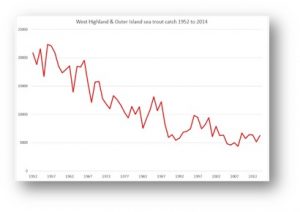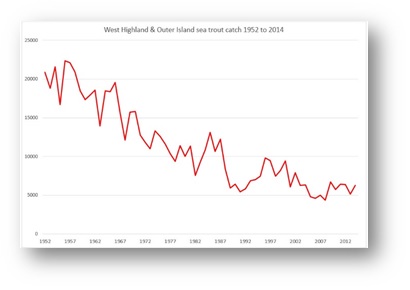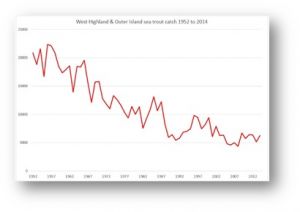Toxic: The Daily Record reports that toxic plastic pollution is ‘destroying’ Scotland’s beaches, lochs and rivers. According to experts, the toxic danger to the environment is getting worse with 80% of the waste originating on land. Reporters from the newspaper visited a number of areas but they found one of the worst-hit areas was Arrochar, at the head of Loch Long in Argyll. One local resident said that plastic from all over the world, including, Europe, The US and China, is left behind when the tide goes out. The waste includes bags, bottles, hard hats, in fact, almost anything. The plastic gets carried up the River Clyde but because the loch is narrow, the plastic waste is not washed back to sea and is left on the beach.
Loch Long is only a stone’s throw from Loch Fyne and hence the beginning of the west coast aquaculture zone. Yet, whilst plastic waste is being washed in with the tides and as the Daily Record says is ‘destroying’ the lochs and beaches, it is the salmon industry that has been portrayed as the main culprit as far as the environment is concerned with the Scottish Parliamentary Rural Economy and Connectivity Committee opting shortly to conduct a wide-ranging enquiry in to the impacts of the industry. The Environmental Committee has also jumped in on the act with the news that it is to review the environmental impacts of salmon farming too. With both committees getting involved, the impression is that the Scottish west coast must be an outright environmental disaster, but rather surprisingly, it is just a handful of people who are creating a lot of noise in the media. Amongst them are Salmon & Trout Conservation Scotland who are responsible for the petition that has led to the Parliamentary enquiry. Their complaint is not that the west coast is an environmental disaster in the way that the Daily Record suggests, but that they believe salmon farming is responsible for the decline in the numbers of wild salmon and sea trout that their members try to catch for sport. The enquiry will no doubt consider this question, but also discuss other impacts of salmon farming too. Over the coming weeks, we, at Callander McDowell, will consider some of the issues that we think that the enquiry will raise. As long as the enquiry is conducted in a fair and even manner and not as a witch-hunt, we think that the Committee Members will not find issue with the way that salmon are farmed in Scotland today.
We were not planning to begin our review of the impacts of salmon farming with the question of wild fish as it is a subject that has already been given a great deal of coverage however, Salmon & Trout Conservation are trying to ensure the issue retains a high profile in the media in the run up to the enquiry. To this end, Salmon & Trout Conservation have issued yet another press release, with some coverage in the mainstream press. S&TC claim that a new scientific study confirms that salmon farming is to blame for the decline of wild fish populations. The new study has been written by Professor Eva Thorstad and one of her colleagues from the Norwegian Institute for Nature Research (NINA).
Eva Thorstad and the S&TC have more in common than first appears. For example, they both have blocked Callander McDowell on Twitter. Whilst they both are keen to express their views on the impacts of salmon farming on wild fish, they are not so willing to listen to the views of others. This is an issue that could affect the livelihoods of many people working in isolated rural areas, yet S&TC persist in issuing relentless press releases pointing the finger at the salmon farming industry, but they are extremely reluctant to make these claims in person. We have certainly made every effort to meet with S&TC director Andrew Graham Stewart but have never heard back from him. When the subject of contact came up in a local newspaper, S&TC responded claiming that they had received no such email communication from us but that it showed their ‘spam’ box was working. Their response when some of our views appeared in the public arena was to describe our lead as ‘Dr Crapper’ because of the ‘crap’ we write. The reality is that whilst they are happy to make accusation after accusation, they do not like to have their views challenged.
This new study, whilst clearly a PR opportunity, actually brings nothing new to the debate. This is because S&TC paid NINA to write a report for them that supports their claims. Clearly, they wouldn’t be so willing to pay for a report that suggests the decline in wild stocks is not linked to salmon farming. The report, whilst dressed up as a scientific study, presents exactly what S&TC want to hear. It’s not even new material as it is simply a review paper of very selective information. We, at Callander McDowell would be happy to supply a different narrative, albeit one they don’t want to hear, for no cost.
Mr Graham Stewart always like to include a statement in his press releases which can be used by the press as a quote. This time he says that ‘For many years we have maintained that the Scottish Government’s position – that there is no evidence in Scotland that sea lice from salmon farming damage wild salmon and sea trout populations – is untenable. This report substantiates our view that it would be very odd indeed if the Scottish situation was markedly different to elsewhere Ewe do after all have the same sea lice…..and the same wild fish’.
What Mr Graham Stewart implies is that the report he commissioned and paid for suggests that salmon farming is responsible for declines of wild fish in Norway and thus why should Scotland be any different. We, agree why should Scotland be any different to Norway? However, we suggest that perhaps that it is S&TC and NINA that are mistaken and that actually, salmon farming is equally not responsible for the declines of wild fish in Norway. This is something that we have argued repeatedly but researchers in Norway have become so blinkered to the issues that they can no longer see the reality.
We, at Callander McDowell, would be more than happy to debate the issues contained in his report with him. We would even be happy to discuss them in reLAKSation if that is what our readers would like to hear but meantime there is one short paragraph in the report which we would like to highlight:
‘All these results mentioned above have been summarized in ICES (2016), agreed upon and these estimates indicate marked variability with losses in individual experiments ranging from 0.6% to 39%. The results suggest that sea lice induced mortality has an impact on Atlantic salmon returns, which may influence the achievement of conservation requirements for affected stocks (ICES 2016).’
We have written before now that our Dr Martin Jaffa attended the ICES workshop mentioned in the above paragraph from the report. He has an issue with two words in the paragraph – agreed upon – because the results mentioned were not agreed upon. Martin disagreed with them for one, however, the leaders of the groups involved in the workshops weren’t interested and just forced through their own views. Martin raised a number of issues about the way salmon are farmed but any concerns were not discussed because they were not part of the workshop’s terms of reference. We have previously mentioned that Martin also gave a short presentation that included data that contradicted some of the then research. Not one of the thirty or so participants asked a single question. This was because most weren’t interested in any other view except the ones that they were themselves promoting – that salmon farming is to blame. Martin asked for his name to be removed from the workshop, but ICES refused, even though he disagreed with some of the conclusions. It seems that when considering Norwegian research, it is impolite to question or challenge the research. When it comes to the enquiry, we at Callander McDowell will have no hesitation in challenging Mr Graham Stewart and the S&TC and we expect that the enquiry will allow us to do so. After all, salmon farming is an important part of the way of life and economy of Scotland’s west coast and if salmon farming is to be labelled as a threat to the environment, then the Parliamentary Committees should ensure that no stone remains unturned in finding the truth.
We would like to mention that it was not just the S&TC that gave coverage to wild salmon and sea trout this week. BBC Alba broadcast the start of a new series of Turas a’Bhradain. This is the fourth series exploring the world of salmon and fly fishing in Scotland. The programme can still be viewed on iplayer within the UK. This first programme visited rivers in the Hebrides, an area which is also part of the west coast aquaculture zone.
Presenter and keen angler, Neen MacKay, discussed why some anglers were unhappy that they could no longer kill any fish to eat when caught from some rivers. There was also a small feature about salmon farming, after which Neen concluded:
‘Fish farming is widely blamed for the collapse in wild salmon stocks but whilst fish farming is undoubtedly a contributory factor, new scientific research indicates more significant problems in the North Atlantic could pose a far greater threat to the species.’
We hope Mr Graham Stewart and Parliamentary Committee members were watching.
Finally, we would like to contribute to the debate by offering this graph which shows sea trout catches by rod and line from the Western Highland & Outer Islands of Scotland, ie the heart of the aquaculture zone from 1952 to 2014. If salmon farming is the cause of the collapse of sea trout stocks then perhaps S&TC can explain why sea trout stocks are showing such a massive decline from 1952 to 1980, the time before commercial salmon farming got underway. If anything, after the arrival of salmon farming, the decline looks like it has slowed not increased.

Half marks: We mentioned last week that we were not that impressed with the salmon offering over Christmas in many stores. As Christmas fades from memory, the store groups are now reporting their Christmas sales and it seems that it was not a happy time for everyone.
The Guardian newspaper reported that Marks & Spencer had seen sales of foods fall by 0.4%. We are not surprised because we were not that impressed with the range that M&S put on their shelves. However, Christmas food is much more than salmon and M&S did score some successes. This year, they saw sales of organic turkey increase by 42% but it seems that having bought their turkey, shoppers did not stop to buy the trimmings.
The problem for salmon sales was that M&S did not invest in the small treat-like products this year probably because the price of the raw material was too high. At the same time, those products they did stock were priced highly and shoppers were more aware that the budget chains were offering similar products at much lower prices. M&S were simply uncompetitive. This is a big change because M&S food was always considered reliable at Christmas and it doesn’t seem it is any more.
Meanwhile, salmon prices must better reflect the needs of those who buy it. It is worth remembering that it doesn’t matter what the price of salmon is if consumers choose not to put their hand in their pocket anymore.
Meanwhile, M&S have started the year by offering two fish dishes in their £10 Dine In promotion. The choice is salmon with hoisin sauce or sea bass fillets with Kalamata Olive butter. These have to compete with nine other dishes including sirloin steak and a rotisserie chicken in a sweet and sticky marinade.
No take off: Just before Christmas, Salmon Business quoted Roger Hofseth of Hofseth Aqua as saying that the enclosed farm concepts, that have been widely reported over the past year, are unlikely to take off. Mr Hofseth describes these ‘space projects’ as ‘pricy science fiction’ and we, at Callander McDowell tend to agree.
There has been a rush to come up with new concepts that in part desperate salmon from the scourge of sea lice. This is because of new green licences and the imposition of the traffic light system. We have always thought these projects were an over-reaction, but also are unrealistic.
Mr Hofseth says that the most effective way to farm fish is the way that it is already done. This especially applies to cost and this, he believes, will be the main driver of change, He said that long-term, normalisation of salmon prices is good, as reflected by prices which have already dropped from above NOK 70/kg to below NOK 50/kg. Prices around this level or lower will bring into question whether these proposed new ventures can be profitable. Mr Hofseth thinks that they will never get off the drawing board because these new ideas will be too costly to develop. He said that good biology and effective cost management is the way forward. He is absolute right, but we would also argue that there needs to be a proper debate about the impacts of salmon farming than approaches like the traffic light system which owe more to the same science fiction as do these doomed space projects.


